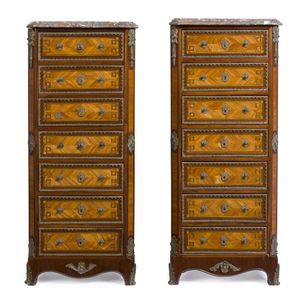French Marquetry Semainier with Ormolu Mounts and Marble Top
You must be a subscriber, and be logged in to view price and dealer details.
Subscribe Now to view actual auction price for this item
When you subscribe, you have the option of setting the currency in which to display prices to $Au, $US, $NZ or Stg.
- Inlay - Decorative patterns inserted into the main body of a piece of furniture, generally in wood of contrasting colour and grain, though brass, ivory, ebony, shell and sometimes horn have been used. Inlay may consist of a panel of well figured timber inset into a cabinet door front, geometric patterns, or complex and stylized designs of flowers, swags of foliage, fruits and other motifs. As a general rule, in pieces where the carcase is constructed in the solid, the inlay is relatively simple such as stringing, cross banding and herringbone banding. Where more elaborate and decorative work was required veneer was used. Inlay has been fashionable from at least the latter half of the 17th century, when a variety of elaborate forms were developed
- Ormolu - Ormolu was popular with French craftsmen in the 18th and 19th century for ornamental fittings for furniture, clocks and other decorative items. True ormolu is gilt bronze, that is bronze that has been coated with gold using a mercury amalgam. Due to the health risks associated with using mercury, this method of creating ormolu was discontinued in France in the 1830s. A substitute was developed consisting of about 75% copper and 25% zinc, however it was inferior to the bronze version. It was often lacquered to prevent it tarnishing.
- Marquetry - In marquetry inlay, contrasting woods, and other materials such as ivory, shell and metal are inlaid either as panels or in a single continuous sheet over the surface of the piece. The design may be straightforward, such as a shell pattern or a basket of flowers, or it may be infinitely complex, with swirling tendrils of leaves, flowers and foliage, such as one finds, for example, in the "seaweed" patterns on longcase clocks of the William and Mary and Queen Anne periods.
This item has been included into following indexes:
Visually similar items

A Napoleon III gilt bronze mounted marble top kingwood secretaire Wellington chest, 129 cm high, 67 cm wide, 38 cm wide

A vintage mahogany Wellington chest, seven drawers, raised on plinth base, requires some attention. Width 62 cm, depth 40 cm, height 112 cm.

An English George IV mahogany chest on chest, the base fitted with three long drawers and above five drawers. 199 cm high, 107 cm wide, 53 cm deep.

A fine mahogany Wellington chest, 19th century, the seven drawer chest having a plain extended top above seven full width drawers of graduating depth and supported on a plinth base, with a lockable vertical hinged flap, decorative corbels and turned knob h
